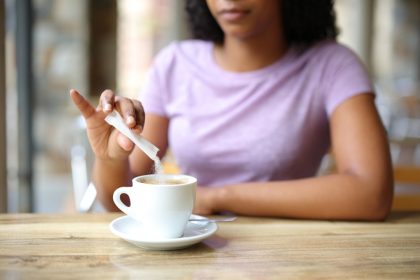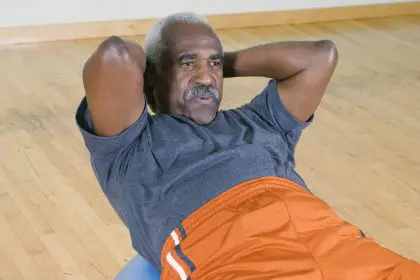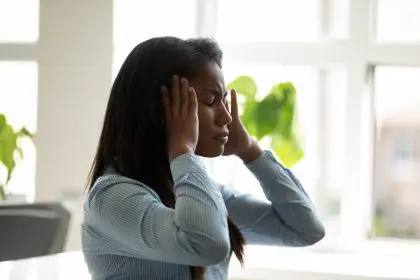The number of candles on your birthday cake may tell you how many years you’ve been alive, but they reveal surprisingly little about how well your body is actually aging. Biological age—how your body functions compared to chronological benchmarks—offers a much more accurate picture of your health status and longevity prospects. While sophisticated biomarker testing and genetic analysis can measure biological age with precision, researchers have identified a remarkably simple physical test that predicts health outcomes with stunning accuracy. Taking just 10 seconds to perform, this accessible assessment reveals insights about balance, brain health, and mortality risk that even expensive medical screenings might miss.
The balance challenge that predicts longevity
The deceptively simple test requires no special equipment or medical supervision: stand on one leg for 10 seconds. This seemingly straightforward task integrates multiple bodily systems into a single observable measurement, creating a window into overall physiological functioning that sophisticated imaging cannot capture.
To perform the assessment correctly, stand barefoot on a flat, non-slippery surface with arms relaxed at your sides. Lift one foot approximately six inches off the ground, bending that knee slightly while keeping the supporting leg straight. The raised foot should not touch the standing leg, and the eyes should remain open, looking straight ahead. A timer begins when the foot lifts and stops if the raised foot touches the floor, the supporting foot shifts, or when 10 seconds elapses.
While anyone might wobble slightly during the test, the ability to maintain this position without significant adjustment correlates strongly with physiological resilience across multiple systems. The assessment engages proprioception, vestibular function, motor control, cognitive processing, and muscular strength simultaneously—making it an integrated measure of whole-body health.
Research involving multiple age groups consistently shows that performance on this simple balance test tracks closely with mortality risk, cognitive health, and physical independence. Adults unable to complete the 10-second balance show significantly higher mortality rates over subsequent years compared to those who pass the test, even when controlling for other health metrics and demographic factors.
Perhaps most revealing, balance ability declines in a predictable pattern with advancing age but varies dramatically between individuals of similar chronological age. This variation reflects biological aging processes more accurately than birth dates, offering insights into internal health that might otherwise remain hidden.
What the test reveals about your body systems
Balance represents an extraordinarily complex neurological and physiological achievement that requires seamless integration across multiple body systems. The 10-second assessment provides a window into how effectively these systems communicate and function together.
Vestibular system health forms the foundation of balance ability. Located in the inner ear, this sensory network detects head position and movement, sending continuous signals to the brain about spatial orientation. Premature aging or dysfunction in this system manifests immediately in balance testing, often before other symptoms appear.
Proprioception—the body’s awareness of position in space—also plays a crucial role in balance maintenance. This subtle sense depends on nerve receptors in muscles, tendons, and joints that continuously update the brain about body position. Age-related decline in proprioceptive sensitivity typically begins in mid-adulthood but accelerates significantly in those experiencing faster biological aging.
Vision contributes substantially to balance performance as well. The eyes provide external orientation cues that help maintain stability, particularly when vestibular or proprioceptive signals weaken. Changes in visual processing speed—a marker of neurological aging—appear during balance assessment even when standard eye exams detect no abnormalities.
Perhaps most significantly, the test evaluates cerebellar function. This brain region coordinates complex movement patterns and rapidly integrates sensory information from throughout the body. The cerebellum shows particular vulnerability to aging processes, with its function correlating strongly with overall brain health and cognitive capacity.
Muscle response time and strength, particularly in the lower extremities, also factor into balance performance. The ability to make micro-adjustments quickly enough to prevent falls depends on both neural signaling efficiency and muscular responsiveness—both sensitive indicators of biological age.
The most revealing aspect of the test may be how it assesses brain-body communication pathways. The speed and accuracy with which the nervous system processes sensory information and generates appropriate motor responses determines balance capability. This neurological efficiency declines with biological aging but responds remarkably well to targeted interventions.
Interpreting your performance
Age-specific benchmarks help contextualize individual performance on the 10-second balance test. Most healthy adults under 50 should easily maintain the position for the full duration. Between ages 50-60, approximately 80% of adults can complete the test successfully, with this percentage dropping to around 70% for those in their 60s, 50% for those in their 70s, and below 30% for those in their 80s.
However, these statistics represent population averages rather than optimal health standards. The inability to maintain balance at any age suggests accelerated biological aging in one or more body systems. Particularly concerning is balance failure in adults under 65, which correlates strongly with significantly higher mortality risk over subsequent decades.
Beyond the basic pass/fail measurement, subtle observations during the test provide additional insights. Excessive arm movement for stabilization, pronounced wobbling, or intense concentration required to maintain position all suggest borderline function and elevated biological age relative to chronological age.
Side-to-side differences in balance ability reveal further information about neurological health. A substantial performance gap between standing on the right versus left leg may indicate asymmetrical brain-body communication pathways, often reflecting subtle neurological issues that elude standard medical screening.
The time of day when testing occurs also influences performance, with greater balance stability typically observed in morning hours and decline as the day progresses. This diurnal variation becomes more pronounced with advancing biological age, creating larger performance gaps between morning and evening assessments.
Most revealing, perhaps, is the trajectory of balance ability over time. Regular assessment tracking—performing the test monthly and noting subtle changes—provides insight into aging progression that occasional medical checkups might miss. Rapid decline over months suggests accelerated biological aging warranting medical evaluation.
How the test connects to brain health
Beyond physical health predictions, balance performance provides a window into current brain function and future cognitive resilience. The neural circuitry required for maintaining equilibrium overlaps substantially with pathways involved in memory, attention, and executive function.
The cerebellum, which coordinates balance, also plays crucial roles in cognitive processing, emotional regulation, and attention allocation. Declining cerebellar function appears in balance performance before cognitive symptoms emerge, making the 10-second test a potential early indicator of brain aging.
White matter integrity—the health of neural communication pathways throughout the brain—strongly influences both balance ability and cognitive performance. Age-related changes in these connective fibers affect motor control early, offering a glimpse into the brain’s overall communication efficiency.
Perhaps most significantly, the test evaluates cognitive-motor integration—the brain’s ability to coordinate thinking and movement simultaneously. This integration frequently deteriorates in the earliest stages of several neurological conditions, often years before formal diagnosis through conventional testing.
Regular balance practice not only assesses brain health but actively promotes it. The neuroplasticity stimulated through balance challenges encourages new neural connections that support both motor control and cognitive function. This brain-training effect helps explain why individuals who regularly engage balance systems often maintain cognitive sharpness longer than those with more sedentary lifestyles.
The cognitive benefits extend beyond the cerebellum and motor regions. Balance maintenance requires substantial input from the prefrontal cortex—the brain area responsible for planning, decision-making, and personality expression. Regular activation of these prefrontal networks through balance challenges appears to strengthen overall executive function.
The connection between balance and brain health appears particularly strong regarding fall prediction. Cognitive processing speed—how quickly the brain interprets and responds to information—plays a crucial role in preventing falls. The 10-second test indirectly measures this processing speed through balance performance, offering insights into both physical security and mental sharpness.
Improving your score and lowering your health age
The remarkable aspect of the balance test lies not just in its diagnostic value but in how quickly performance can improve with targeted practice. Unlike many biomarkers of aging that change slowly, balance ability responds rapidly to specific interventions, potentially lowering biological age across multiple systems.
Simple daily balance practice creates measurable improvement within weeks. Standing on one leg while brushing teeth, waiting in lines, or during television commercial breaks provides cumulative training that strengthens neural pathways. Initially, using fingertip support on a countertop or chair helps develop confidence, with support gradually reduced as stability improves.
Adding cognitive challenges during balance practice accelerates improvement and enhances brain benefits. Reciting phone numbers backward, naming animals alphabetically, or performing simple arithmetic while balancing creates dual-task training that strengthens cognitive-motor integration pathways. These combined challenges mimic real-world situations that require simultaneous thinking and movement.
Vision training substantially enhances balance performance by improving one key input system. Practicing balance first with eyes open, then closed, then while tracking moving objects trains the brain to integrate visual information more effectively with other sensory inputs. This visual processing efficiency translates into both better balance scores and improved reaction time in daily activities.
Proprioceptive enhancement through varied surface training also improves test results quickly. Practicing balance on different textures—carpet, foam pads, grass, or unstable surfaces—forces proprioceptive sensors to become more sensitive and accurate. This enhanced body-position awareness creates more precise movement control in all activities.
Vestibular system responsiveness improves through head movement incorporation during balance practice. Slowly turning the head side-to-side or up-and-down while balancing stimulates inner ear function, enhancing the brain’s ability to maintain orientation during movement. This vestibular training proves particularly valuable for adults over 60, when inner ear sensitivity naturally declines.
Beyond specific balance exercises, overall movement variety throughout daily life substantially improves test performance and lowers biological age markers. Activities requiring multidirectional movement—dance, tennis, tai chi, or playground play—create neural adaptations that enhance balance control from multiple angles. This movement diversity stimulates brain regions that might otherwise remain underutilized.
Nutrition significantly impacts balance performance through its effects on neural signaling and muscle response. Anti-inflammatory eating patterns support the nervous system infrastructure required for precise balance control. Particular emphasis on omega-3 fatty acids, antioxidants, and adequate protein intake supports the neural repair processes needed for optimal brain-body communication.
Sleep quality perhaps influences balance performance more than any factor besides direct practice. During deep sleep phases, the brain consolidates movement patterns practiced during waking hours and repairs neural communication pathways. Consistent, sufficient sleep enables the nervous system recalibration necessary for optimal balance performance.
The broader health implications
The value of the 10-second balance test extends beyond its specific measurement of equilibrium. Performance correlates strongly with several health outcomes and biomarkers typically requiring more invasive or expensive assessment.
Insulin sensitivity—how effectively cells respond to insulin’s signals—shows a surprising connection to balance ability. Research indicates that adults who maintain longer single-leg stance times typically demonstrate better glucose regulation, even when controlling for body composition. This connection likely stems from shared neural pathways involved in both motor control and metabolic regulation.
Inflammation levels—now recognized as central drivers of aging processes—also correlate with balance performance. Those unable to complete the 10-second test often show elevated inflammatory markers in blood testing. Balance training appears to reduce these inflammatory compounds, suggesting direct anti-aging effects beyond the nervous system.
Cardiovascular health measures, particularly arterial stiffness and blood pressure regulation, demonstrate consistent relationships with balance test results. The connection appears bidirectional—better cardiovascular function supports neural tissue health needed for balance, while balance training improves cardiovascular regulation through autonomic nervous system effects.
Bone density shows especially strong correlations with balance ability across all adult age groups. The micro-movements required to maintain equilibrium create osteogenic (bone-building) stress that maintains mineral density. Those who pass the 10-second test consistently show higher bone density in hip and spine measurements compared to age-matched peers who fail the assessment.
Psychological resilience—the ability to navigate stress effectively—also correlates with balance test performance. The focused attention required for balance maintenance engages the same neural circuits used for emotional regulation. This connection helps explain why balance-focused activities like tai chi and yoga demonstrate profound effects on both physical stability and mental well-being.
Longevity prediction represents perhaps the most profound application of the simple test. Multiple longitudinal studies tracking adults over decades consistently show that balance ability predicts mortality risk independent of other health factors. The integrative nature of the assessment—its requirement for multiple systems functioning harmoniously—creates a window into overall physiological resilience that specialized tests might miss.
Making the test part of your health routine
The accessibility of the balance assessment makes it an ideal addition to regular health monitoring routines. Unlike blood tests or medical imaging, it requires no appointment, equipment, or expertise to perform.
Creating a monthly assessment habit provides the most valuable health tracking information. Performing the test on both legs under similar conditions—same time of day, comparable footwear (or barefoot), similar surface—allows for meaningful comparison over time. Recording results, perhaps alongside other simple measures like resting heart rate or weight, creates a personal health dashboard revealing subtle trends.
For adults over 50, performing the test weekly offers additional benefits through the practice effect. This frequency not only monitors health status but actively improves it through neural pathway reinforcement. The cumulative training effect of regular assessment transforms the test from merely diagnostic to actively therapeutic.
Family assessment creates both accountability and valuable health insights across generations. Performing the test with children and elderly family members reveals fascinating patterns of development and aging. Young children typically master single-leg balance around age four, with performance peaking in early adulthood before gradual decline begins in mid-life.
Balance assessment following illness or injury provides particularly valuable recovery tracking. The integrative nature of the test makes it sensitive to systemic health changes that specialized medical testing might overlook. Significant performance decline after seemingly minor illnesses may warrant further medical evaluation.
Physician sharing represents an often-overlooked application of regular testing. Bringing personal balance performance data to medical appointments provides healthcare providers with functional information that complements standard clinical assessments. This objective measurement of physical capability often reveals health changes that subjective symptom reporting might miss.
The test offers particular value during medication adjustments or new treatment protocols. Many medications—especially those affecting blood pressure, neurological function, or vestibular systems—influence balance performance before other side effects become apparent. Tracking balance ability during medication changes provides early feedback about how these treatments affect functional health.
Finding your true health age
The fundamental value of the 10-second test lies in its ability to reveal functional age independent of chronology. Two 65-year-olds may share a birth year while inhabiting bodies functioning decades apart biologically.
The gap between functional abilities and chronological age often widens in mid-adulthood. Many individuals maintain youthful balance performance well into their 70s through active lifestyles and targeted training. Others show accelerated decline in their 50s due to sedentary patterns, metabolic issues, or neurological changes. The 10-second assessment reveals these divergent aging trajectories that might otherwise remain hidden.
This insight into true health age empowers proactive intervention before significant problems develop. Balance decline often precedes falls or mobility limitations by months or years, creating a window for preventive action. Regular assessment allows for early detection of changes that, addressed promptly, may prevent cascading health challenges.
Perhaps most importantly, the test reveals that biological age remains modifiable regardless of chronological age. Adults of all ages demonstrate remarkable capacity to improve balance performance through consistent practice, with corresponding enhancements in overall health measures. This adaptability continues even in advanced years, challenging fatalistic views of aging as an inevitable decline.
The 10-second balance test ultimately offers something beyond measurement—it provides motivation. The immediate feedback and visible progress create engagement with health improvement that abstract numbers like cholesterol levels or blood pressure readings rarely generate. This tangible connection to functional capability often catalyzes broader lifestyle changes that enhance overall wellbeing.
By revealing the gap between chronological and biological age, the simple assessment empowers individuals to take active roles in their aging trajectories. The test transforms aging from something that happens to you into a process you actively influence, one balanced moment at a time.














